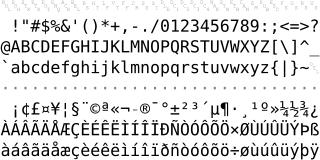Related Research Articles
Extended Binary Coded Decimal Interchange Code is an eight-bit character encoding used mainly on IBM mainframe and IBM midrange computer operating systems. It descended from the code used with punched cards and the corresponding six-bit binary-coded decimal code used with most of IBM's computer peripherals of the late 1950s and early 1960s. It is supported by various non-IBM platforms, such as Fujitsu-Siemens' BS2000/OSD, OS-IV, MSP, and MSP-EX, the SDS Sigma series, Unisys VS/9, Unisys MCP and ICL VME.

ISO/IEC 8859-1:1998, Information technology — 8-bit single-byte coded graphic character sets — Part 1: Latin alphabet No. 1, is part of the ISO/IEC 8859 series of ASCII-based standard character encodings, first edition published in 1987. ISO/IEC 8859-1 encodes what it refers to as "Latin alphabet no. 1", consisting of 191 characters from the Latin script. This character-encoding scheme is used throughout the Americas, Western Europe, Oceania, and much of Africa. It is the basis for some popular 8-bit character sets and the first two blocks of characters in Unicode.
ISO/IEC 8859 is a joint ISO and IEC series of standards for 8-bit character encodings. The series of standards consists of numbered parts, such as ISO/IEC 8859-1, ISO/IEC 8859-2, etc. There are 15 parts, excluding the abandoned ISO/IEC 8859-12. The ISO working group maintaining this series of standards has been disbanded.
ISO/IEC 646 is a set of ISO/IEC standards, described as Information technology — ISO 7-bit coded character set for information interchange and developed in cooperation with ASCII at least since 1964. Since its first edition in 1967 it has specified a 7-bit character code from which several national standards are derived.
ANSEL, the American National Standard for Extended Latin Alphabet Coded Character Set for Bibliographic Use, was a character set used in text encoding. It provided a table of coded values for the representation of characters of the extended Latin alphabet in machine-readable form for thirty-five languages written in the Latin alphabet and for fifty-one romanized languages. ANSEL adds 63 graphic characters to ASCII, including 29 combining diacritic characters.
ISO/IEC 8859-7:2003, Information technology — 8-bit single-byte coded graphic character sets — Part 7: Latin/Greek alphabet, is part of the ISO/IEC 8859 series of ASCII-based standard character encodings, first edition published in 1987. It is informally referred to as Latin/Greek. It was designed to cover the modern Greek language. The original 1987 version of the standard had the same character assignments as the Greek national standard ELOT 928, published in 1986. The table in this article shows the updated 2003 version which adds three characters. Microsoft has assigned code page 28597 a.k.a. Windows-28597 to ISO-8859-7 in Windows. IBM has assigned code page 813 to ISO 8859-7. (IBM CCSID 813 is the original encoding. CCSID 4909 adds the euro sign. CCSID 9005 further adds the drachma sign and ypogegrammeni.)
ISO/IEC 8859-16:2001, Information technology — 8-bit single-byte coded graphic character sets — Part 16: Latin alphabet No. 10, is part of the ISO/IEC 8859 series of ASCII-based standard character encodings, first edition published in 2001. The same encoding was defined as Romanian Standard SR 14111 in 1998, named the "Romanian Character Set for Information Interchange". It is informally referred to as Latin-10 or South-Eastern European. It was designed to cover Albanian, Croatian, Hungarian, Polish, Romanian, Serbian and Slovenian, but also French, German, Italian and Irish Gaelic.
GB/T 2312-1980 is a key official character set of the People's Republic of China, used for Simplified Chinese characters. GB2312 is the registered internet name for EUC-CN, which is its usual encoded form. GB refers to the Guobiao standards (国家标准), whereas the T suffix denotes a non-mandatory standard.
MARC is a standard set of digital formats for the machine-readable description of items catalogued by libraries, such as books, DVDs, and digital resources. Computerized library catalogs and library management software need to structure their catalog records as per an industry-wide standard, which is MARC, so that bibliographic information can be shared freely between computers. The structure of bibliographic records almost universally follows the MARC standard. Other standards work in conjunction with MARC, for example, Anglo-American Cataloguing Rules (AACR)/Resource Description and Access (RDA) provide guidelines on formulating bibliographic data into the MARC record structure, while the International Standard Bibliographic Description (ISBD) provides guidelines for displaying MARC records in a standard, human-readable form.

ArmSCII or ARMSCII is a set of obsolete single-byte character encodings for the Armenian alphabet defined by Armenian national standard 166–9. ArmSCII is an acronym for Armenian Standard Code for Information Interchange, similar to ASCII for the American standard. It has been superseded by the Unicode standard.
ITU-T recommendation T.50 specifies the International Reference Alphabet (IRA), formerly International Alphabet No. 5 (IA5), a character encoding. ASCII is the U.S. variant of that character set.
Windows code page 1253, commonly known by its IANA-registered name Windows-1253 or abbreviated as cp1253, is a Microsoft Windows code page used to write modern Greek. It is not capable of supporting the older polytonic Greek.

The Chinese Character Code for Information Interchange or CCCII is a character set developed by the Chinese Character Analysis Group in Taiwan. It was first published in 1980, and significantly expanded in 1982 and 1987.
ISO 2709 is an ISO standard for bibliographic descriptions, titled Information and documentation—Format for information exchange.
YUSCII is an informal name for several JUS standards for 7-bit character encoding. These include:
ASMO 449 is a, now technologically obsolete, 7-bit coded character set to encode the Arabic language.
ISO 6438:1983, Documentation — African coded character set for bibliographic information interchange, is an ISO standard for an 8-bit character encoding for African languages. Developed separately from the African reference alphabet but apparently based on the same data sets, it has had little use; its forms are retained Unicode.
The ISO basic Latin alphabet is an international standard for a Latin-script alphabet that consists of two sets of 26 letters, codified in various national and international standards and used widely in international communication. They are the same letters that comprise the current English alphabet. Since medieval times, they are also the same letters of the modern Latin alphabet. The order is also important for sorting words into alphabetical order.
The MARC-8 charset is a MARC standard used in MARC-21 library records. The MARC formats are standards for the representation and communication of bibliographic and related information in machine-readable form, and they are frequently used in library database systems. The character encoding now known as MARC-8 was introduced in 1968 as part of the MARC format. Originally based on the Latin alphabet, from 1979 to 1983 the JACKPHY initiative expanded the repertoire to include Japanese, Arabic, Chinese, and Hebrew characters, with the later addition of Cyrillic and Greek scripts. If a character is not representable in MARC-8 of a MARC-21 record, then UTF-8 must be used instead. UTF-8 has support for many more characters than MARC-8, which is rarely used outside library data.
ISO 5426 is a character set developed by ISO, similar to ISO/IEC 6937. It was first published in 1983.
References
- ISO 5428:1984 "Greek alphabet coded character set for bibliographic information interchange"
- MARC 21 Specifications for Record Structure, Character Sets, and Exchange Media > Character Sets > Part 3: Code Tables (Character Sets) > Code Table 8: Greek
- "Greek Character Tables: ISO 5428-1980"
- "Greek alphabet coded character set for bibliographic information interchange" (June 1, 1982) (cached copy)
- "Greek alphabet character set for bibliographic use" (August 13, 1976; older standard) (cached copy)